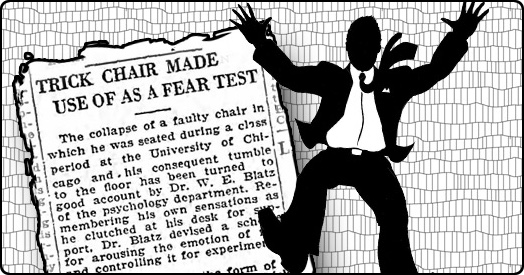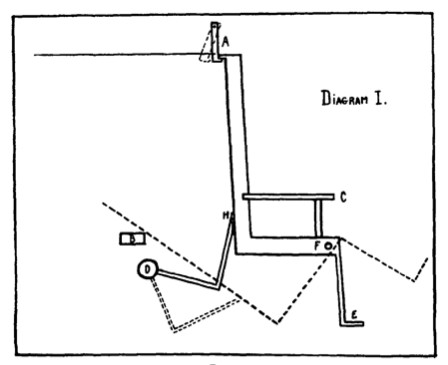Dr. Blatz’s Trick Chair of Terror

While he was a grad student at the University of Chicago in the early 1920s, William Blatz was sitting in class one day, leaning back in his chair, when suddenly the chair collapsed beneath him, sending him sprawling backwards, crying out in fright. The experience was unsettling, but it gave him an idea for an unusual psychology experiment.
He designed a trick chair that would collapse backwards without warning when he flipped an electric switch. The chair was padded, so its occupant wouldn't get hurt. But Blatz figured that the sensation of abruptly, unexpectedly falling backwards would provoke a strong, measurable reaction in subjects. This would allow him to study the physiology of fear under controlled, repeatable conditions. He performed his experiment on a series of unsuspecting victims.

Diagram of Blatz's trick chair.
When the hook (A) at the top was released, the chair plunged backwards.
Experimental Design
Eighteen subjects (7 male and 11 female) participated in the study. Blatz gave them no warning about the nature of the experiment. In fact, he told them the experience would be very relaxing. He said they would merely sit in a padded chair for 15 minutes, while he recorded their heart rate. He suggested they might even fall asleep during the experiment.

After securely fastening the subject in the chair, Blatz attached electrodes to their arm, to measure heart rate and electrical conductivity of the skin. He used an electrical pneumograph to measure the subject's respiration. Then Blatz went into an adjoining room. leaving the subject alone.
To lull the subjects into a false sense of security, Blatz made them sit through three fifteen-minute sessions (spread over a few days) during which nothing happened. By the fourth sitting, the subjects had become accustomed to the routine. It was then that he triggered the surprise. After they had been in the chair for a few minutes and were fully relaxed, Blatz pressed the switch, the chair collapsed, and the subject pitched backward. Blatz offered this description of their reactions:
"The observations of the subjects after the fall, of course, varied, but they were sufficiently in agreement to indicate the arousal of genuine fear in naive subjects. Some examples of these remarks were, 'startled,' 'surprised,' 'frightened,' scared,' etc. In most cases the subjects cried out, and some called the experimenter by name. They all made some effort to escape, thinking an accident had happened. In all cases they acknowledged that they had not anticipated 'anything like it at all.' From these statements, it was concluded that the stimulus was wholly unexpected, and unsuspected."
The electrodes registered the effect of the fright. The hearts of the subjects began hammering, and their breathing rapidly increased. Blatz also observed "striking changes in the electrical conditions of the body in the nature of an increased development of the electromotive force."

The physiological response of a subject to a collapsing chair
Follow-up
After the initial fall, Blatz couldn't surprise the subjects in the same way again. But he conducted several more sittings with each subject, during which he told them to expect a fall, but not exactly when. Although the subjects didn't report the same level of shock in these subsequent sittings, Blatz found that their heart rates nevertheless increased and their breathing quickened whenever the chair suddenly collapsed beneath them.
Blatz also subsequently mentioned pulling his collapsing-chair trick on several unsuspecting victims who became so enraged that they chased him from the room.
Blatz conducted this experiment as part of his graduate work at the University of Chicago. He subsequently became a well-known child psychologist who worked with, and authored a book about, the Dionne quintuplets.
References
- Blatz, W.E. (1925). "The cardiac respiratory and electrical phenomena involved in the emotion of fear." Journal of Experimental Psychology. 8: 109-132.
- "Trick Chair Tests Fear Reactions" (Sep 6, 1924). The Science News-Letter, 5(178): 4.
- "William E. Blatz, Psychologist, 69" (Nov 2, 1964). The New York Times.
- "William E. Blatz," wikipedia.
Comments
This post combines the themes of the last two: Blatz, and people falling down.
Posted by Dr. Fian on 12/26/17 at 12:22 PM
I'm surprised that he didn't go on to design theme park rides.
Posted by KDP on 12/26/17 at 03:36 PM
Commenting is not available in this channel entry.


Category: Experiments | Psychology | 1920s